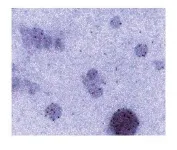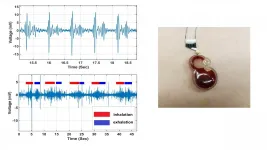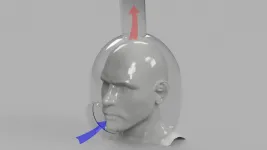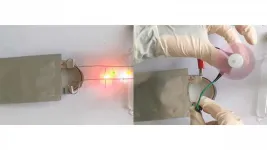Scientists identify 'immune cop' that detects SARS-CoV-2
Antiviral protein MDA-5 senses viral replication and governs immune response to SARS-CoV-2
2021-01-12
(Press-News.org) LA JOLLA, CALIF. - Jan 12, 2020 - Scientists at Sanford Burnham Prebys Medical Discovery Institute have identified the sensor in human lungs that detects SARS-CoV-2 and signals that it's time to mount an antiviral response. The study, published today in Cell Reports, provides insights into the molecular basis of severe disease and may enable new strategies for the treatment and prevention of COVID-19.
"Our research has shown that MDA-5 is the immune cop that's tasked to keep an eye out for SARS-CoV-2 and call for back-up," says Sumit Chanda, Ph.D., director of the Immunity and Pathogenesis Program at Sanford Burnham Prebys and senior author of the study. "MDA-5 recognizes replicating viruses in lung cells and activates interferon, the body's own frontline defender against viral invasion. Without a proper interferon response, viral infections can lead to deadly, out-of-control inflammatory reactions."
The new study surveyed 16 viral RNA binding proteins in human lung epithelial cells and identified MDA-5 as the predominant sensor responsible for activating interferon. MDA-5 detects double-stranded viral RNA--a form that the SARS-CoV-2 virus takes when it replicates to spread the infection. Prior to this research, it was known that activating interferon is key to a coordinated immune response to the virus, but the sentinel switch that controls the process was unknown.
"Understanding the biology of a virus and how it is detected is paramount to controlling infection and disease spread," says Chanda. "SARS-CoV-2 appears to disable the innate immune arm of our surveillance system, which, in the case of SARS-CoV-2 is controlled by MDA-5, and prevents the activation of interferon. It's the interferon response that drives the subsequent activation of many genes that exert antiviral activities--and data suggests that we need this activity to control early stages of viral infection and avoid the worst outcomes of COVID-19.
"Whether our bodies can defeat the virus's offensive tactics and activate interferon greatly influences the severity of disease. Past studies have shown that interferon responses are higher in patients with mild-to-moderate cases compared to reduced levels in critically ill patients," adds Chanda.
According to the World Health Organization, as of January 2020 there have been nearly 87 million confirmed cases of COVID-19, including nearly 1.9 million deaths. Although remdesivir and two antibody treatments have received emergency use authorization by the FDA, cases continue to rise. Newly approved vaccines are rapidly being deployed worldwide to end the crisis, however a handful of people are experiencing severe allergic reactions to the shots.
"There is still a tremendous need to develop effective therapies for COVID-19 and to prepare for future outbreaks," says Chanda. "It's possible that patients who become critically ill are deficient in the interferon signaling pathway. This research opens new avenues toward therapies that enhance the MDA-5 signaling to boost interferon levels early in infection to prevent severe disease.
"It also creates opportunities to develop COVID-19 vaccines that include an adjuvant(s) to enhance MDA-5 signaling. These would be formulations that use less 'vaccine' to minimize toxicity and side effects," adds Chanda.
INFORMATION:
The first author of the study is Xin Yin, Ph.D., of Sanford Burnham Prebys and the Chinese Academy of Agricultural Sciences. Additional study authors include Paul D. De Jesus, Kristina Herbert, Laura Martin-Sancho, Yuan Pu, Laura Riva, Chih-Cheng Yang and Sunny Yoh of Sanford Burnham Prebys; Jun Kanamune, Shimpei Gotoh and Yuki Yamamoto of Kyoto University; Kouji Sakai of the National Institute of Infectious Diseases (Tokyo); Judd F. Hultquist of Northwestern University; and Lisa Miorin and Adolfo Garcia-Sastre of the Icahn School of Medicine at Mount Sinai.
The study's DOI is 10.1016/j.celrep.2020.108628.
This work was supported by the following grants to the Sanford Burnham Prebys Medical Discovery Institute: DoD: W81XWH-20-1-0270; DHIPC: U19 AI118610; Fluomics/NOSI: U19 AI135972; R01 AI127302-01A1, as well as generous philanthropic donations from Dinah Ruch and Susan & James Blair. This work was additionally supported by the following grants to Northwestern University Feinberg School of Medicine: a CTSA supplement to NCATS: UL1 TR002389; a CTSA supplement to NUCATS with the generous support of the Dixon family: UL1 TR001422; and a Cancer Center supplement: P30 CA060553. This work was also partly supported by CRIP (Center for Research for Influenza Pathogenesis), an NIAID-supported Center of Excellence for Influenza Research and Surveillance (CEIRS, contract # HHSN272201400008C), by NIAID grant U19AI142733, by NCI grant U54CA260560, by supplements to NIAID grant U19AI135972 and DoD grant W81XWH-20-1-0270, by the Defense Advanced Research Projects Agency (HR0011-19-2-0020), and by the generous support of the JPB Foundation, the Open Philanthropy Project (research grants 2020-215611 and 2020-218415) and anonymous donors to Adolfo Garcia-Satre. Development and implementation of iPSC technology for production of airway epithelial cells was supported by the Incubation Program from the Office of Society-Academia Collaboration for Innovation, Kyoto University.
About Sanford Burnham Prebys Medical Discovery Institute
Sanford Burnham Prebys is a preeminent, independent biomedical research institute dedicated to understanding human biology and disease and advancing scientific discoveries to profoundly impact human health. For more than 40 years, our research has produced breakthroughs in cancer, neuroscience, immunology and children's diseases, and is anchored by our NCI-designated Cancer Center and advanced drug discovery capabilities. For more information, visit us at SBPdiscovery.org or on Facebook at facebook.com/SBPdiscovery and on Twitter @SBPdiscovery.
[Attachments] See images for this press release:

ELSE PRESS RELEASES FROM THIS DATE:
2021-01-12
Key Takeaways:
Machine learning can be an effective tool to set competitive prices.
Artificial intelligence has its limits on how to set the most effective prices due to variables beyond the seller's control.
Over the long term, supracompetitive pricing can result.
CATONSVILLE, MD, January 12, 2021 - Machine learning and artificial intelligence (AI) are perfectly suited to help companies and marketers monitor and set prices based on real-time dynamic pricing. But new research has identified some possible unintended consequences of AI in this area.
Machine learning algorithms don't always account for factors outside of the seller's control, such as competitor prices. Researchers ...
2021-01-12
The daily toll of COVID-19, as measured by new cases and the growing number of deaths, overlooks a shadowy set of casualties: the rising risk of mental health problems among health care professionals working on the frontlines of the pandemic.
A new study, led by University of Utah Health scientists, suggests more than half of doctors, nurses, and emergency responders involved in COVID-19 care could be at risk for one or more mental health problems, including acute traumatic stress, depression, anxiety, problematic alcohol use, and insomnia. The researchers found that the risk of these mental health conditions was comparable to rates observed during natural disasters, such as 9/11 and Hurricane Katrina.
"What health care workers are experiencing is akin to domestic combat," says ...
2021-01-12
LOS ANGELES (Jan. 11, 2021) -- Cell-derived exosomes are effective in treating disease when mixed with the dominant protein in breast milk and given orally, a new Smidt Heart Institute study of laboratory mice shows. The findings, published in the peer-reviewed Journal of Extracellular Vesicles, could help develop new oral medications for treating patients with muscular dystrophy and heart failure.
The study builds on more than a decade of research led by Eduardo Marbán, MD, PhD, executive director of the Smidt Heart Institute and Cedars-Sinai professor of Cardiology. The research has focused on human cardiosphere-derived ...
2021-01-12
Most consumers of drinking water in the United States know that chemicals are used in the treatment processes to ensure the water is safe to drink. But they might not know that the use of some of these chemicals, such as chlorine, can also lead to the formation of unregulated toxic byproducts.
Johns Hopkins Environmental Health and Engineering Prof. Carsten Prasse proposes a new approach to assessing drinking water quality that could result in cleaner, safer taps.
"We are exposing people in the United States to these chemical compounds without knowing what they ...
2021-01-12
During a typical year, over a million people visit Yellowstone National Park, where the Old Faithful geyser regularly blasts a jet of boiling water high in the air. Now, an international team of astronomers has discovered a cosmic equivalent, a distant galaxy that erupts roughly every 114 days.
Using data from facilities including NASA's Neil Gehrels Swift Observatory and Transiting Exoplanet Survey Satellite (TESS), the scientists have studied 20 repeated outbursts of an event called ASASSN-14ko. These various telescopes and instruments are sensitive to different wavelengths of light. By using them collaboratively, scientists obtained more detailed pictures of the outbursts.
"These are the most predictable and frequent recurring multiwavelength ...
2021-01-12
WASHINGTON, January 12, 2021 -- A highly sensitive wearable sensor for cardiorespiratory monitoring could potentially be worn continuously by cardiac patients or others who require constant monitoring.
The small and inexpensive sensor, announced in Applied Physics Letters, by AIP Publishing, is based on an electrochemical system involving two ionic forms of iodine, I- and I3-. A solution containing these electrolyte substances is placed into a small circular cavity that is capped with a thin flexible diaphragm, allowing detection of subtle movements when placed on a patient's chest.
Small motions that arise from the heartbeat and breathing cause the flexible diaphragm ...
2021-01-12
Stiffness in our tissues causes tension in our cells. Research from the Buck Institute, the University Health Network (University of Toronto), Stanford University, and the University of Alberta shows that stiffness impacts the innate immune system by upping its metabolism. The findings suggest the cellular tension likely sets off an inflammatory loop that contributes to the development of chronic diseases of aging. Publishing in Cell Reports, Buck Associate Professor Dan Winer, MD, and colleagues present an emerging way of looking at how the immune system functions, possibilities for new immunotherapeutics, and a call for scientists to reconsider the way they do research.
While stiffness ...
2021-01-12
WASHINGTON, January 12, 2021 -- The risk of infection of COVID-19 is high for medical specialists who come in contact with symptomatic or asymptomatic patients. Dentists and otolaryngologists are at particular risk, since they need direct access to the mouth, nose, and throat of patients.
The current solutions, which include wearing N95 masks and face shields, clinic room evacuation, negative pressure rooms, and special air filtration systems, are expensive, not highly effective, and not very accessible.
In Physics of Fluids, by AIP Publishing, researchers at Cornell University discuss their design of an open-faced helmet for patient use ...
2021-01-12
WASHINGTON, January 12, 2021 -- Sodium-ion batteries are a potential replacement for lithium batteries, but the anodes -- positively charged electrodes -- that work well for lithium-ion batteries don't provide the same level of performance for sodium-ion batteries.
Amorphous carbon, which lacks a crystalline structure, is known to be a useful anode, because it has defects and voids that can be used to store sodium ions. Nitrogen/phosphorus-doped carbon also offers appealing electrical properties.
In Applied Physics Reviews, from AIP Publishing, researchers in China from Zhejiang University, Ningbo University, and Dongguan University of Technology ...
2021-01-12
What The Study Did: Variations and changes in national and state rates of neonatal abstinence syndrome and maternal opioid-related diagnoses were examined in this observational study.
Authors: Ashley H. Hirai, Ph.D., of the Health Resources and Services Administration in Rockville, Maryland, is the corresponding author.
To access the embargoed study: Visit our For The Media website at this link https://media.jamanetwork.com/
(doi:10.1001/jama.2020.24991)
Editor's Note: The article includes conflicts of interest and funding/support disclosures. Please see the article for additional information, including other authors, author contributions and affiliations, conflict of interest and financial disclosures, and funding and support.
INFORMATION:
Media advisory: ...
LAST 30 PRESS RELEASES:
[Press-News.org] Scientists identify 'immune cop' that detects SARS-CoV-2
Antiviral protein MDA-5 senses viral replication and governs immune response to SARS-CoV-2




